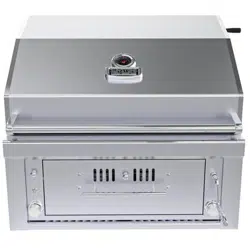Loading ...
Loading ...
Loading ...

Page 25
CARE & MAINTENANCE – Rust-Brown Marks
When Rust-Brown marks staining occurs, it is very unlikely that the material itself is rusting. The rust marks
are the result of small particles of “ordinary-steel” which have become attached to the surface; usually
through the manufacturing process. These brown marks are only superficial stains, which will not harm the
Grill; they should be removable using a soft damp cloth and a multi-purpose cream cleanser. We
recommend "Naval Jelly" which is available from your local Home Depot. Occasionally, it may be necessary
to resort to a proprietary stainless steel cleanser, to return the surface of the Grill to its original condition.
Always first give grill full cleaning to remove all these impurities from the steel surface. Since these
ordinary-steel particles have been on the surface for some time, it is common for them to show signs of
Rust-Brown marks fairly quickly. Be sure to follow a regular practice of maintaining your BBQ grill, to avoid
this in the future. See below Examples of the main three reasons for Rust-Brown Marks.
PITTING:
Is often the result of impurities resting on the
surface of the stainless steel from the
manufacturing process. These impurities on
the steel than can cause superficial rusting
spots. When this corrosive attack occurs it can
often happen after BBQ’s first exposure to the
outside elements, or after the first use, when
steel is heated then cooled causing stress to
the steel reveling these impurities.
BLEACHES:
Bleaches & sterilizing solutions contain chlorine
in the form of sodium hypochlorite. Bleaches
can attack the stainless steel, causing pitting of
the surface and surface staining. In most cases,
this happens when the proximity of BBQ to
Pools or Spas with high chemical content that
drifts onto surface of BBQ. All cleaning agents
containing hypochlorite are unsuitable for long
term contact with stainless steel and, even
when used in the highly diluted form, they can
give pitting under certain conditions.
FOODSTUFFS:
Typically found in the groves along were two
edges come together, creating an area were
food stuffs collect. In general stainless steel is
fully resistant to all foodstuffs in common use.
Only in isolated cases, such as when
concentrated salt and vinegar mixtures are
allowed to remain in contact with the steel for a
long period can any surface marking result.
Loading ...
Loading ...
Loading ...
